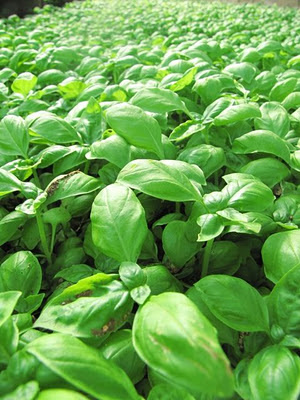This past summer, I excitedly planted my first container garden. It was pretty much a flop. I stupidly crowded too many tomato plants into each container and added too much perlite to my soil mix, resulting in about 10 yellow cherry tomatoes and one small plum tomato and exactly two purple heirlooms, which the squirrels got to before I did. Oh yeah, and the world's smallest green pepper. I did manage to grow three huge healthy basil plants. We recently brought those in for the winter. They are not doing so well. I had to put them in my office, where my cats can't eat them and where sadly there's not much sun.
So in honor of my basil plants that are on their last legs, I thought why not give them the best send off I can and make something that showcases basil like nothing else can. Pesto! Originating in Genoa, it is traditionally made in a marble mortar and pounded or crushed by a wooden pestle. The word pesto actually comes from the Genoese word pesta, which means to pound; our word pestle comes from this by the way of Latin.
Basil is a pretty cool little herb. Besides being rather tasty, it contains flavonoids, which help protect cell structure from both radiation and oxidation damage. Basil also has antibacterial properties: studies have shown that it is able to suppress bacteria that have become resistant some antibiotic drugs. Basil is high in beta carotene, which is converted into vitamin A and which helps protect cells from free radical damage. Basil is one powerful little herb!
Pesto Genovese with Pasta
I call it Genovese pesto because it's a more traditional style pesto, but I have a feeling that the residents of Liguria would scoff at that. The Ligurians are very particular about their pesto like the French with their grapes and don't really consider anything that's not made with Ligurian basil grown in Liguria to be real pesto (at least that's what I heard). It's almost the same principal as terroir in wine making; the soil in Linguria gives certain characteristics to the basil, as well as the sea air and the amount of sun. Although I'm actually using Lingurian basil (mixed with some sweet basil) in my recipe, it was not grown in Liguria. Also I am using my food processor, which is probably pretty cringe worthy, but I've tried the pounding method and it's not for me. I hope they will forgive me though!
1 pound pasta (I used farfalle because that's what I had on hand)
2 cups basil loosely packed
1/2 -1 clove garlic (I vary it on my mood whether I want it more or less garlicy)
3 tblsp pine nuts
1/2 - 1 cup olive oil depending on how thin or thick you want it
3/4 - 1 cup freshly grated Parmigiano Reggiano
Coarse sea salt - start with a pinch or two and keep adding until satisfied (be careful not to over salt as the Parmigiano is already salty)
Boil water and cook pasta as directed.
Meanwhile, combine the basil with a pinch or two of salt, the garlic, the pine nuts, and about half of the oil in a food processor. Process, stopping to scrape down the sides as you are processing, gradually adding the rest of the oil. Stir in the Parmegiano right before serving. Pour pest into a bowl and add pasta gentle stirring to mix.
I had a package of heirloom mini tomatoes laying around so I tore them up and added them to the pesto. Sometimes I like the sweet acidity with my pesto. You can really add anything to it. I think grilled veggies make a lovely addition.
Buona Sallute,
Karen



No comments:
Post a Comment